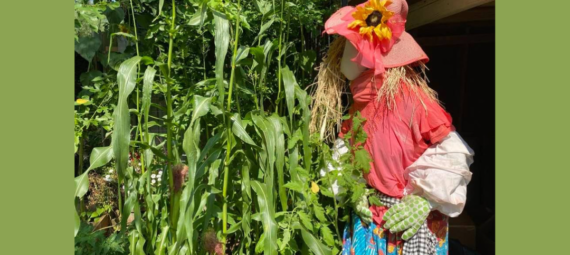
Corn growing in Jacki Kellum’s 2022 Garden – The Scarecrow’s name was Lady Gardensong
Last year, I had a small, shady garden space, and much of that space was compromised by an immense walnut tree that spread across most of my back yard. But I tried to grow corn anyway. I didn’t get more that 5 ears of corn, but I was hooked. This year, I’m in Mississippi, and my yard is very sunny. I plan to try the corn again, but this year, I plant to plant my corn in hills where I’ll also plant green beans and squash. This method of planting is called Three Sisters Gardening. I plan to begin planting the corn tomorrow, on June 23, and by all standards, that is late. Again, my moving to Mississippi has caused my garden to be late, but I plan to plant Silver Queen corn, and I should be able to harvest some corn by the end of September. In my opinion, that’s fine.

Image Credit: Wikimedia
Corn stalks growing for fall decorating, and some fresh corn of my own to boil and eat. If I can find someone to show me how to do it, I’d love to fry some corn. That’s a Southern delicacy.
What Is a Three Sisters Garden?

Image: The classic milpa with maize-bean-squash by Lopez-Ridaura, S., Barba-Escoto, L., Reyna-Ramirez, C. A., Sum, C., Palacios-Rojas, N., & Gerard, B. is used under the Creative Commons Attribution 4.0 International License (CC BY 4.0).
“Some Indigenous Peoples of the Americas planted corn, beans and squash or pumpkins together in mounds, in an intercropping complex known to some as the Three Sisters. Corn provided support for beans, beans provided nitrogen through nitrogen-fixing rhizobia bacteria that live on the roots, and squash and pumpkins provided ground cover to suppress weeds and inhibit evaporation from the soil. While the origins of the Three Sisters complex are unknown, veneration of the Three Sisters appears in the earliest accounts of European explorers and missionaries in North America. As described by Lewandowski, from its earliest appearance in written records, the Three Sisters complex was not simply an agricultural strategy or technology, but a cultural complex, complete with stories, ceremonies, technology, customs and etiquette.
“Archaeological evidence dates the adoption of the Three Sisters complex in North America to 1070 AD
The Three Sisters of Indigenous American Agriculture | National Agricultural Library. www.nal.usda.gov/collections/stories/three-sisters.
The Kellogg Garden site adds that growing corn, green beans, and squash together serves more than one purpose:
“The ‘three sisters’ were the vegetables: pole beans, squash, and corn — plants that seem to grow better together than they do apart, and which provide more nutrition when eaten together because they make up what’s called a ‘complete protein.’…
The tall and sturdy corn stalks provide support for the vining bean plant, while the beans’ roots provide nitrogen-fixing bacteria by pulling nitrogen out of the air to share with the corn. Then, the large squash leaves provide shade to minimize weeds and conserve moisture for all three plants.
Best Way to Plant Pole Beans, Squash, and Corn
1. Choose heirloom varieties of pole beans, squash, and corn. A combination of sweet corn, stringless green beans, and zucchini are ideal, but make sure to choose plant varieties that are recommended for your area.
2. Plant all three plants in small groups, spaced out 2 ½ – 3 feet apart.
3. Plant small groups in “hills.” These hills are raised mounds for better drainage in wet areas or shallow depressions to catch and absorb water in dry areas.
4. Plant hills in blocks. This block or grid pattern (rather than a straight line pattern) aids in pollination, which leads to better vegetable formation and increased harvest.
5. Plant corn first, followed by beans and squash. According to the recommendations for planting times in your area, plant your corn plant or sow your corn seeds first. When the corn is about 6” tall, plant 2-3 bean seeds about 6” from the base of each corn plant. Finally, plant 2-3 squash seeds (spaced about 6” apart) in their own hills between the hills of corn and beans.
6. Keep weeded until squash vines grow to cover the ground. Do this by mulching your garden or hoeing until squash vines are large enough to shade out the weeds below.
Kellogggarden. “Best Way to Plant Pole Beans, Squash and Corn.” Kellogg Garden OrganicsTM, 22 July 2021, kellogggarden.com/blog/gardening/best-way-to-plant-pole-beans-squash-and-corn.

